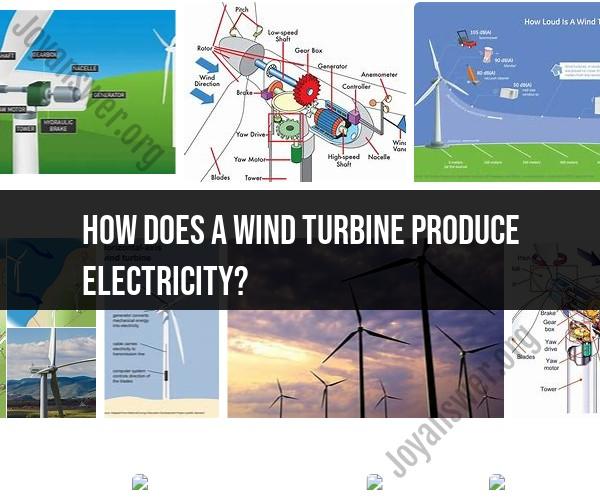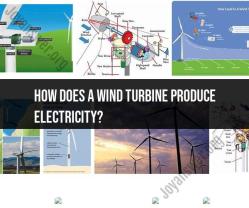How does a wind turbine produce electricity?
A wind turbine generates electricity through a process that converts the kinetic energy of the wind into electrical energy. Here's a step-by-step explanation of how a wind turbine produces electricity:
Wind Capture: Wind turbines are designed with tall towers and large rotor blades. The tower raises the turbine high above the ground to access stronger and more consistent wind currents.
Blade Rotation: As the wind blows, it impacts the surface of the rotor blades. The shape and design of the blades are crucial in capturing the kinetic energy of the wind. Wind turbines typically have two or three blades attached to a hub that is connected to the main shaft.
Rotation of the Blades: The force of the wind causes the rotor blades to start spinning around a central axis, which is connected to a generator at the top of the tower. This rotation is powered by the wind and results in the mechanical energy of the spinning blades.
Mechanical Energy: The spinning rotor blades generate mechanical energy, which is transferred to the generator through the main shaft. The kinetic energy of the moving blades is converted into rotational energy within the generator.
Generator: The generator is a critical component that transforms the mechanical energy into electrical energy. It consists of a rotor (attached to the main shaft) and a stator (stationary part). Inside the generator, electromagnetic fields are created as the rotor spins within the stator.
Electromagnetic Induction: The relative motion between the rotor and the stator induces a flow of electrons, creating an electric current. This process is based on the principles of electromagnetic induction, as described by Faraday's law.
Electricity Generation: The electric current generated in the generator is initially in the form of alternating current (AC). This AC electricity is then transmitted down the tower through electrical cables.
Conversion to Usable Electricity: Before being fed into the electrical grid or used locally, the AC electricity may go through a power converter to convert it into direct current (DC) or adjust its voltage levels as needed.
Integration with the Grid: If the wind turbine is part of a wind farm or connected to the electrical grid, the electricity generated is typically transmitted to a substation. There, it is synchronized with the grid's frequency and voltage before being distributed for use.
Use or Distribution: The electricity generated by the wind turbine can be used to power homes, businesses, and industries, or it can be fed into the grid to supplement the overall electricity supply.
Wind turbines are a sustainable and renewable source of energy, and their operation is dependent on the consistent flow of wind. Modern wind turbines are designed for efficiency, with features such as variable blade pitch and yaw control to optimize power generation under varying wind conditions.
Power from Thin Air: How Wind Turbines Generate Electricity
Wind turbines are a type of renewable energy technology that use wind to generate electricity. Wind turbines work by converting the kinetic energy of the wind into mechanical energy, which is then converted into electrical energy by a generator.
Wind Energy Unveiled: The Science Behind Turbine-Powered Electricity
The science behind wind turbines is relatively simple. Wind turbines have blades that are designed to capture the wind and convert its energy into mechanical energy. The blades are attached to a rotor, which is connected to a generator. As the wind blows over the blades, they turn the rotor, which spins the generator. The generator produces electricity as it spins.
The amount of electricity that a wind turbine can generate depends on a number of factors, including the size and number of blades, the wind speed, and the efficiency of the generator. Wind turbines are typically located in areas where the wind blows consistently, such as offshore or in mountainous regions.
From Breeze to Electricity: The Wind Turbine's Journey
The wind turbine's journey from breeze to electricity is as follows:
- The wind blows over the blades of the wind turbine, causing them to turn.
- The blades are attached to a rotor, which spins as the blades turn.
- The rotor is connected to a generator, which produces electricity as it spins.
- The electricity is then transmitted to the grid, where it can be used to power homes and businesses.
Wind turbines are a clean and renewable source of energy. They do not produce any greenhouse gases or other pollutants. Wind turbines are also becoming more affordable and efficient, making them a viable option for meeting our growing energy needs.
Here are some of the advantages of wind energy:
- It is a clean and renewable source of energy.
- It does not produce any greenhouse gases or other pollutants.
- It is becoming more affordable and efficient.
- It can help to reduce our reliance on fossil fuels.
Here are some of the disadvantages of wind energy:
- Wind turbines can be noisy.
- Wind turbines can be visually intrusive.
- Wind turbines can kill birds and bats.
- Wind turbines require a lot of land.
Overall, wind energy is a clean and renewable source of energy with many advantages. It is becoming more affordable and efficient, making it a viable option for meeting our growing energy needs.


